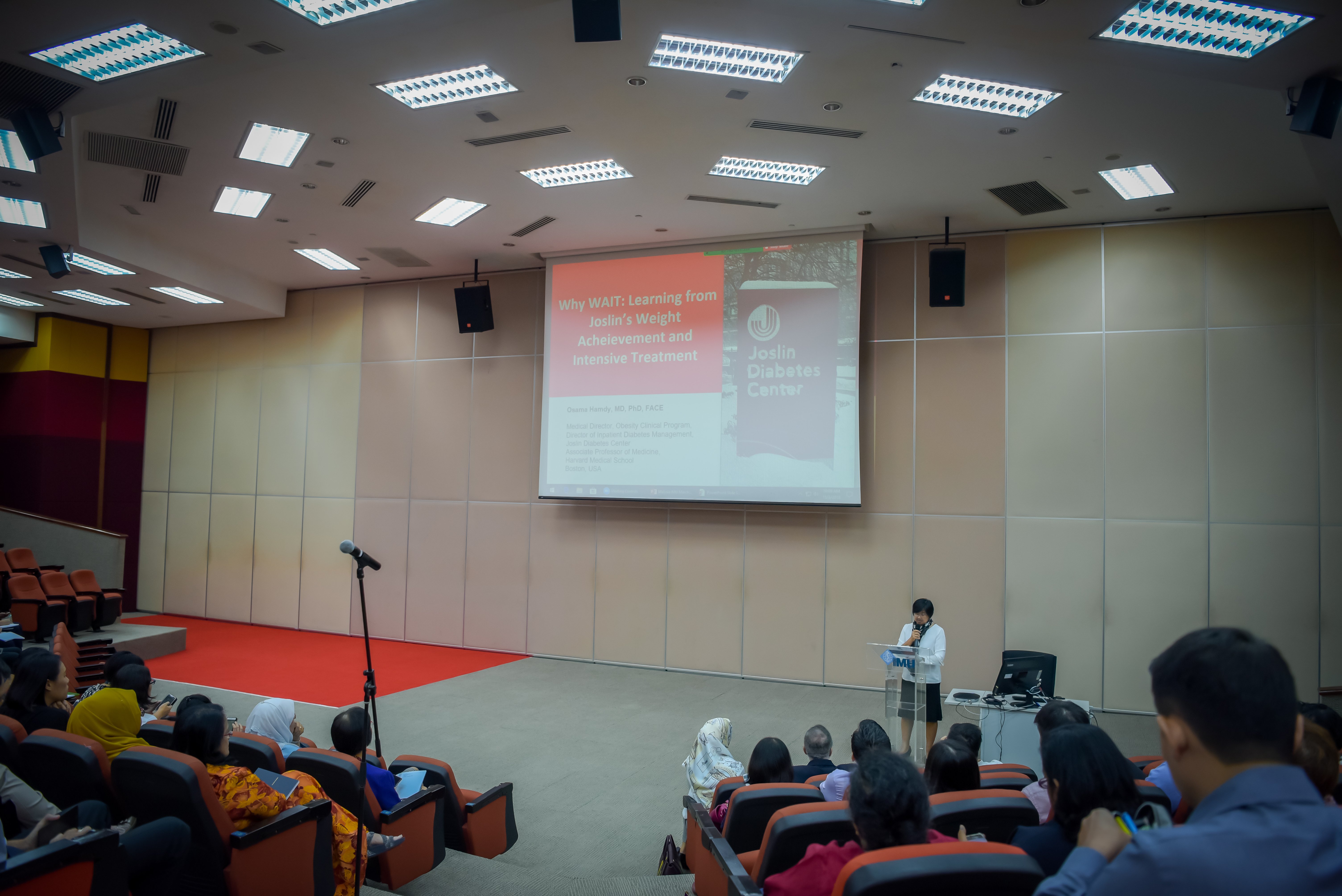Over the past 20 years, the prevalence of type 2 diabetes has increased dramatically from 30 million cases worldwide in 1988 to 239 million cases at present. The World Health Organization (WHO) declared diabetes to be “the health hazard of the 21st century”. Undeniably, diabetes is also a major public health concern in Malaysia. According to the Malaysian National Health and Morbidity Survey (NHMS) 2015, Malaysia has a rising prevalence of type 2 diabetes affecting 17.5% of the adult population, over double since 1996. Most patients with type 2 diabetes are reportedly overweight, obese, or severely obese and its prevalence is increasing rapidly. Data from the 1999–2002 National Health and Nutrition Examination Survey (NHANES) indicate that the prevalence of overweight and obesity among United States adults with diabetes now exceeds 85%. Similarly, the rise in the prevalence of type 2 diabetes is on par with the increasing prevalence of overweight and obesity among Malaysians. It has been highlighted in the National Diabetes Registry 2009-2012 that 83.4% of Malaysian type 2 diabetic patients were obese.  Targeting body weight, as an alternative model to targeting hemoglobin A(1c), is emerging as a viable and potentially cost-effective approach to diabetes management in clinical practice. The Institute for Research, Development, and Innovation (IRDI) in collaboration with the Division of Nutrition and Dietetics from the International Medical University (IMU) had successfully organised a talk titled Diabetes Breakthrough: Learnings from the Joslin’s Why WAIT Program by A/Prof Dr Osama Hamdy from Harvard Medical School in IMU Bukit Jalil campus on March 15, 2018. This event was the first talk of the Translational Research Seminar series organised by IMU’s IRDI.
Targeting body weight, as an alternative model to targeting hemoglobin A(1c), is emerging as a viable and potentially cost-effective approach to diabetes management in clinical practice. The Institute for Research, Development, and Innovation (IRDI) in collaboration with the Division of Nutrition and Dietetics from the International Medical University (IMU) had successfully organised a talk titled Diabetes Breakthrough: Learnings from the Joslin’s Why WAIT Program by A/Prof Dr Osama Hamdy from Harvard Medical School in IMU Bukit Jalil campus on March 15, 2018. This event was the first talk of the Translational Research Seminar series organised by IMU’s IRDI.
| Dr Hamdy is the founder and medical director of the Joslin Obesity Clinical Program. Joslin Diabetes Center is an independent, non-profit institution affiliated with Harvard Medical School, and one of only 11 NIH-designated Diabetes Research Centers in the U.S. It was founded in 1898 by Elliott P. Joslin, M.D. who believed that the key to managing diabetes lay with patient involvement, education, and empowerment. Being strategically located the Longwood Medical and Academic Area in Boston, Massachusetts, Joslin Diabetes Center is well-known as the global leader in diabetes research, care and education with its dedications to conquering diabetes in all of its forms. Its unique, sole focus on diabetes has led the center to be one of the most research-intensive academic medical centers and at the forefront of discovery aimed at preventing and curing diabetes. In addition, Joslin has the world’s largest team of board-certified physicians treating diabetes and its complications, as well as the largest staff of Certified Diabetes Educators anywhere in the world. Today, Joslin has three major divisions: Joslin Research, Joslin Clinic, and Joslin Strategic and Initiatives. |
Dr Hamdy and his team created the Weight Achievement and Intensive Treatment (Why WAIT) programme which was launched in September 2005. It is a 12-week multidisciplinary programme for weight control and intensive diabetes lifestyle management for application in routine practice in type 1 or type 2 diabetes patients. The Why WAIT programme aims to deliver an innovative and achievable diabetes care with a combination of nutritional, exercise, medication, learning and monitoring offerings. Dr Hamdy presented that people with diabetes could reverse the course of type 2 diabetes, lose weight for long term and finally reclaim their health in merely 12 weeks.
| Key aspects of the Why WAIT program include: |
|---|
| – Structured modified dietary intervention with regular food and meal replacements. |
| – Graded, balanced, and individualised exercise intervention that gradually increases from 20 to 30 minutes per day (3 to 4 times/week) to 45 to 60 minutes/day (6 times/week). |
| – Cognitive behavioral intervention. |
| – Intensive and interactive medication adjustments to enhance weight reduction. |
| – Value Group education. |
This model has been effective in improving key metabolic abnormalities observed in diabetic patients. Among the Why WAIT participants, the study found, reaching the target 7% weight loss after one year was a good predictor of maintaining weight loss over longer periods. These varied results were reflected in measurements of glycated hemoglobin A1c (A1c) levels. Eighty-two percent of participants achieved the target A1c of less than 7% on less diabetes medications. A1c is a standard assessment of blood glucose levels over two to three months. Patients with type 2 diabetes seek to keep their A1c levels below 7.0%. On top of that, the achieved weight reduction after 12 weeks of intervention was maintained for an additional year.
With the Why WAIT Program, Dr Hamdy and his Joslin team have helped hundreds of patients in cutting their medications by 50-60%, shedding 5, 10, and even 25 kg, and picking up an exercise regime. On top of all, the Why WAIT Program has been effective in improving key metabolic abnormalities observed in diabetes patients.
It is worth noting that the outcomes from the Why WAIT Program are also replicated by a local randomised controlled trial, led by Prof Winnie Chee, Dean, School of Health Sciences and Professor of Nutrition and Dietetics. The Malaysian study demonstrated the effects of structured lifestyle intervention based on a diabetes-specific nutrition algorithm in individuals with type 2 diabetes. The intervention consisted of structured 1200-1500 low-calorie meal plans, use of 1-2 diabetes-specific meal replacements, and increased physical activity to 150mins/week. Patients were also counseled either through motivational interviewing or conventional counseling.  The results showed that culturally-adapted, structured lifestyle intervention inclusive of medical nutrition therapy (MNT), physical activity, and motivational interviewing significantly improved weight loss and metabolic control in patients with overweight/obesity and type 2 diabetes. Structured lifestyle intervention lowered body weight by 5-8%, lowered body fat and abdominal obesity, and led to a concomitant drop in HbA1c of 0.6-1.0% from baseline as well as lowered blood pressure. These results were very significant and comparable with medication minus side effects! Moreover, those who successfully lost weight reduced their medication dose as well!
The results showed that culturally-adapted, structured lifestyle intervention inclusive of medical nutrition therapy (MNT), physical activity, and motivational interviewing significantly improved weight loss and metabolic control in patients with overweight/obesity and type 2 diabetes. Structured lifestyle intervention lowered body weight by 5-8%, lowered body fat and abdominal obesity, and led to a concomitant drop in HbA1c of 0.6-1.0% from baseline as well as lowered blood pressure. These results were very significant and comparable with medication minus side effects! Moreover, those who successfully lost weight reduced their medication dose as well!
In a nutshell, multidisciplinary weight management approaches are emerging as viable and potentially cost-effective solutions to overweight and obesity management in type 2 diabetes, delaying or minimising the need for medications, reducing cardiovascular risk, and improving the quality of life. With all the new hope this programme is offering to individuals with diabetes, so why wait? Do not settle for a diabetes diagnosis but start shedding the kilos, toss the medications and conquer the diabetes, once and for all!
Related articles: Pelan Pengurusan Diabetes Jenis Dua (Mingguan Malaysia, 25 March 2018)- Article is in Malay Pelan Pemakanan Pesakit Diabetes (Utusan Online, 27 March 2018)- Article is in Malay There might be a cure for diabetes (MSN Singapore, Lifestyle, March 28, 2018) – Article is in English Sending Diabetes Into Remission (Star, 25 March 2018)-Article is in English There might be a cure for diabetes (Star2.com, March 28, 2018) – Article is in English Mengurus Diabetes Jenis 2 (Sinar Harian, 12 April, 2018) tDNA bantu diet pesakit diabetes (Kosmo, 13 April, 2018) Food Intake for Diabetics (Nanyang Siang Pau, 22 April, 2018) Related Podcast: BFM
| References |
|---|
| Hamdy O. Diabetes weight management in clinical practice—the why wait model. US Endocrinology 2008;4(2):49-54. |
| King H, Aubert RE, Herman WH. Global burden of diabetes, 1995-2025: prevalence, numerical estimates, and projections. Diabetes Care 1998 Sep;21(9):1414-1431. |
| Hussein Z, Taher SW, Singh HKG, Swee WCS. Diabetes care in Malaysia: Problems, new models, and solutions. Annals of global health 2015;81(6):851-862. |
| Institute for Public Health. National health and morbidity survey 2015 (NHMS 2015). Vol. II: non-communicable diseases, risk factors and other health problems. Malaysia: Malaysia Institute for Public Health and Ministry of Health Malaysia; 2015. |
| Tee E, Yap R. Type 2 diabetes mellitus in Malaysia: current trends and risk factors. Eur J Clin Nutr 2017;71(7):844. |
| Hamdy O, Goebel-Fabbri A, Carver C, Arathuzik G, Shahar J, Capelson R, et al. Why WAIT program: a novel model for diabetes weight management in routine clinical practice. Obesity Management 2008;4(4):176-183. |
| Chee WS, Singh HKG, Hamdy O, Mechanick JI, Lee VK, Barua A, et al. Structured lifestyle intervention based on a trans-cultural diabetes-specific nutrition algorithm (tDNA) in individuals with type 2 diabetes: a randomized controlled trial. BMJ Open Diabetes Research and Care 2017;5(1):e000384. |
| Feisul M, Azmi S. National diabetes registry report, Volume 1, 2009–2012. Kuala Lumpur: Ministry of Health, Malaysia 2013. |
| Hamdy O, Carver C. The Why WAIT program: improving clinical outcomes through weight management in type 2 diabetes. Current diabetes reports 2008;8(5):413. |
Related articles: UK Researcher Speaks on Targeting the Hypoxic Fraction of Tumours









